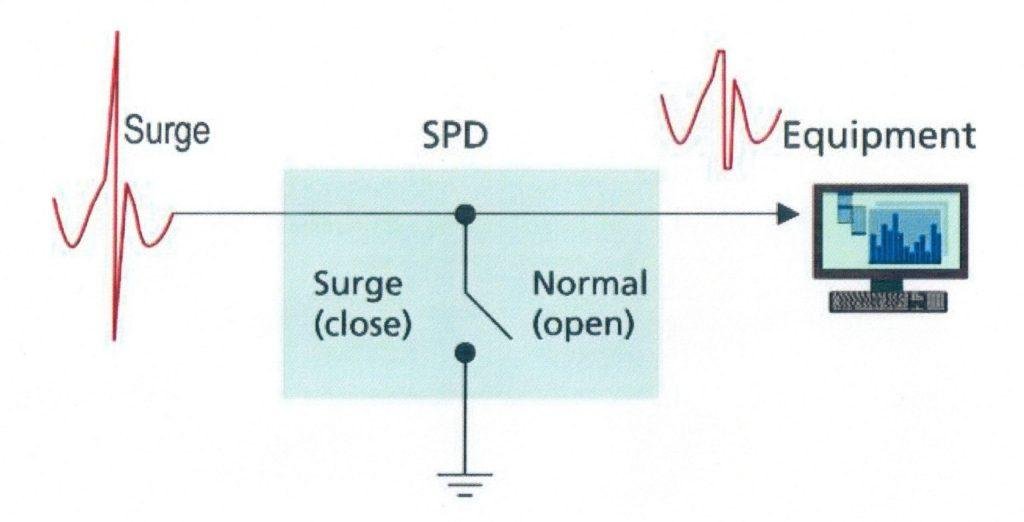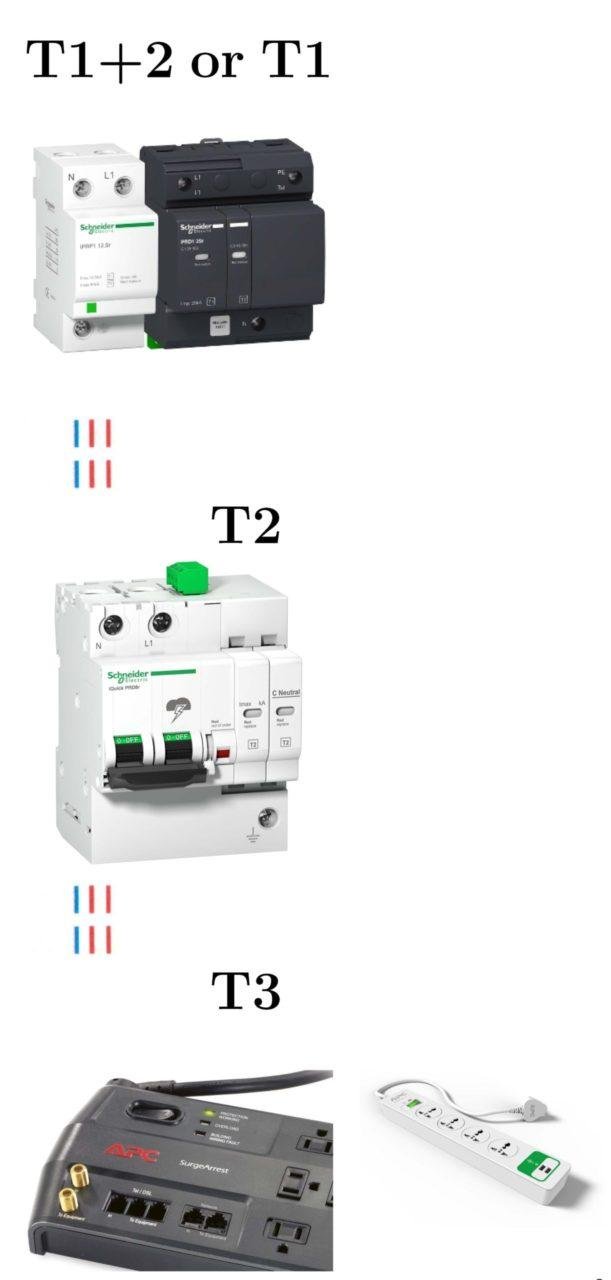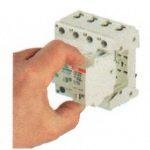Rodhini Safety Pvt. Ltd. customercare@rodhini.com
Mobile: 9495009933
Surges damage electrical equipment, especially electronics. Surges are also a nuisance since they occur frequently.
An electrical power surge is a short duration increase in voltage or current in an electrical circuit. There are two kinds.
An SPD is designed to protect electrical equipment from power surges. It is installed in a parallel path with respect to the load.
Surges trigger the components in the SPD to become a low impedance path and the damaging energy flows from the SPD to the earthing to which it is connected. Once the surge current has subsided, the SPD automatically resets to a state ready to receive the next surge.

The main SPD is connected immediately after the main breaker and in parallel to the load. This SPD is a Type 1 if there is LPS on the building; otherwise, a T1+2 suffices. See the Surge Protection pages under FAQ.
The main SPD is connected immediately after the main breaker and in parallel to the load. This SPD is a Type 1 if there is LPS on the building; otherwise, a T1+2 suffices. See the Surge Protection pages under FAQ.
Heavy duty appliances such as fridge, washing machine, water pump, water heater, and a/c, and kitchen appliances, including micro oven, will now see currents and voltages within their tolerance limits.
The sensitive electronic equipments are still not safe. They need to be plugged into T3 SPD’s which are called point-of-use spd’s.
These three levels of SPD’s comprise what the Institute of Electrical and Electronics Engineers (IEEE) calls “layered protection” with cascading SPD’s.

There are different types of T3 SPD’s. It is convenient to have one like the APC Surgearrest (shown) to which TV, TV cable, and telephone can be plugged into. Computer and printer can be plugged into a simpler T3 called an SPD strip of the type shown on the right of the Surgearrest. It is called a strip because it looks like a strip or rod.
Rodhini has practised layered protection for its customers. We have installed either ABB or Schneider Electric (shown) brands. Both have given uninterrupted operation for five years running so far.
Electricity from sun – photovoltage – is wonderful in many ways. But in countries like India where most areas have lightning, surges come in from the panels. For protection and peace of mind, SPD for photovoltaic systems must be installed. This is particularly necessary as it is difficult to unplug the panels each time the clouds gather!


Most brands of T1, T1+2, and T2 are the pluggable type. This means, when they have caught a lot surges and the indicator on the front begins to change color, you do not have to replace the whole spd; you unplug the cartridge like you change a fuse and plug in the new cartridge which is easily available online.
If you do not have surge protection, the next best thing is to unplug every electronic equipment when you hear thunder far away. But an equipment with unplugged cord can still sustain damage as even a dead wire of length one meter can acquire an induced voltage of 1000 volts in a lightning strike nearby.
he Earth Leakage Circuit Breaker (ELCB) and Residual Current Circuit Breaker (RCCB) cut off power supply by tripping when current leaks to the earth from any electrical/electronic equipment in its network. Nearby high-current lightning strikes can also cause them to trip. This is because voltage gradient occurs in the soil, presenting the ELCB sense coil with enough voltage to cause it to trip. In the case of RCCB, such voltage gradient can also cause current imbalance between the live conductor and neutral in the circuit in which an RCCB is located and hence it may trip. But a lightning current peaks to tens of thousands of Amperes or more in 10 – 350 micro seconds, whereas ELCB, MCB and RCCB can respond only to spikes of duration at least 3000 microseconds (which is 3 milliseconds) because they shut off power mechanically – which takes this much time. So a building with ELCB, MCB, or RCCB but without surge protection situated in an area of lightning activity would still see those units trip but the home appliances and electronic gadgets will be damaged because the damage is done before the tripping. Can we improve the response time of these devices? Yes, that is what SPD’s do. They respond in nanoseconds and so they are over 100000 times faster-acting than ELCB, MCB and RCCB. Uninterruptible Power Supply (UPS) can not also protect appliances and electronic equipment from power surges. UPS will only send power to the equipment but the equipment had already died from the violent voltage spike. In fact, the UPS itself should be fed through a SPD.
hDatalines are present in large offices and data centers. These require protection and are easy to do with dataline SPD’s installed as a T3.

A facility that has both LPS and SPD is fully protected even in most direct lightning strikes. In areas without much lightning activity, SPD alone would be sufficient.
In an area of high lightning activity, like South India, a direct lightning strike can destroy even the installed SPD’s if there is no LPS installed on the structure. On the other hand if there is LPS but no SPD, people and the structure would be safe but not the equipments inside. So LPS and SPD serve different but complementary functions to protect you and your valuables against lightning.
If we have not installed LPS on your building/structure and you need SPD installed, we will direct you to an experienced SPD installation contractor to give you a quote.
Surge protection cost = Cost of surge device + Installation cost.
Cost of surge protection device (SPD) depends on whether a building has single phase or 3-phase wiring. The cost for single phase SPD is up to Rs. 20000 including MCB; otherwise up to Rs. 35000. Installation cost is approximately Rs 4000. This includes travel cost. Our surge protection is currently installed only with our protection from lightning.